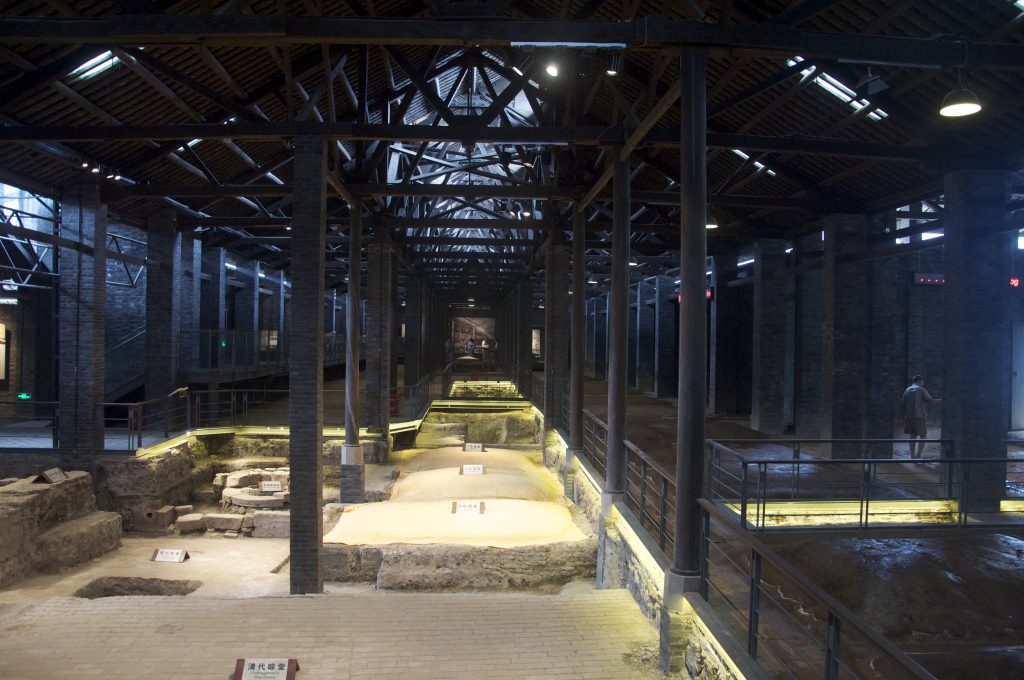Archaeologists unearthed the ruins of a massive distillery in China that dates back to the Ming and Qing dynasties. The discovery is believed to be the most remarkable of its kind ever made in China, as it stretched across some 190,000 square feet. The distillery was a great innovation as it was assumed to have been capable of producing spirits on an industrial scale.
Uncovering of the Ancient Distillery in China:
According to reports, the distillery was unearthed by chance by construction workers, in Suixi County, Anhui Province, which is situated in eastern China. The workers then called the archaeologists who were amazed by the size of their findings.
According to Chen Chao, a researcher of the Provincial Institute of Heritage and Archaeology, three distillation stoves and more than 30 fermenting tanks were discovered. However, out of 18,000 square meters, only 3000 sq. mts. have been excavated, and the rest are yet to be discovered.
Discovery suggesting the distillery was in functioning state for several centuries:
Several other artifacts of previous centuries that were discovered are drinking vessels, bottles, and even cigarette holders. These artifacts discovered in the area of the ancient distillery in China suggest that the site was in operation for many centuries.

Researchers assume that the distillery dates back to the Ming Dynasty (1368-1644). Evidences further justify that it was also making spirits in the Qing Dynasty (1644-1911) which was the last ruling dynasty in China.
However, Chen states that this is only one of the several ancient distilleries discovered in the People’s Republic of China. According to reports, this is the fourth instance of ancient distillery workshop ruins found by Chinese archaeologists.
Two of such ancient distilleries were discovered in southwest China and one in the eastern province of Jiangxi. These sites were spread over a larger geographical area which suggested that distilling was an important activity in ancient China.

Ancient China had the popular practise of drinking fine liquor:
Drinking spirits was a very popular practise among the people in ancient China. Archaeologists claim that the ancient Chinese believed that the beauty of the moment of writing and reciting poetry must be accompanied by the drinking of fine liquor. Refined and cultivated lifestyle was signified by drinking high quality alcoholic beverages. However, excessive drinking and drunkenness was not socially acceptable.

World’s Oldest Distillery is located in China:
The astounding fact remains that the distillery that has been unearthed in Anhui Province, belongs to the same period as the oldest one still in operation in China. It is known as the Shui Jing Fang which was first constructed by a Master Wang in 1408. The distillery is located in Chengdu, China. It has more than 600 years of continuous production, first producing spirits during the Ming Dynasty.

The distillery is popular for its production of White Spirit Baijiu, which forms China’s national drink. Since it is produced using traditional techniques, this distillery is very prestigious throughout the People’s Republic of China. These traditional production techniques of producing spirits have been popularised and listed as “national intangible cultural heritage”.

The original distillery workshop that had been established by Master Wang during the early Ming Dynasty was found during archaeological excavations during 1998. A museum now houses Shui Jing Fang distillery ancient relics from 600 years ago through which visitors can see how spirits are made with traditional methods.
Production of “Liquid Razor Blades” at the Ancient Distillery:
The elites of three major dynasties, the Yuan, Ming and Qing favoured the White Spirits made at Shu Jing Fang. Even after all these ages, the spirits are still high in demand and are possibly the most popular of its kind in the world. Since the drink is very strong, with an intense taste, it has been nicknamed “liquid razor blades.”

After the secret of the distillery in China was unearthed, archaeologists are continuing to work at the site of the distillery in Anhui Province. The discovery is expected to provide invaluable insights into the distilling mechanisms of medieval China.
Read also: The Giant Stone Spheres in Costa Rica: Speculations Behind their Creation
